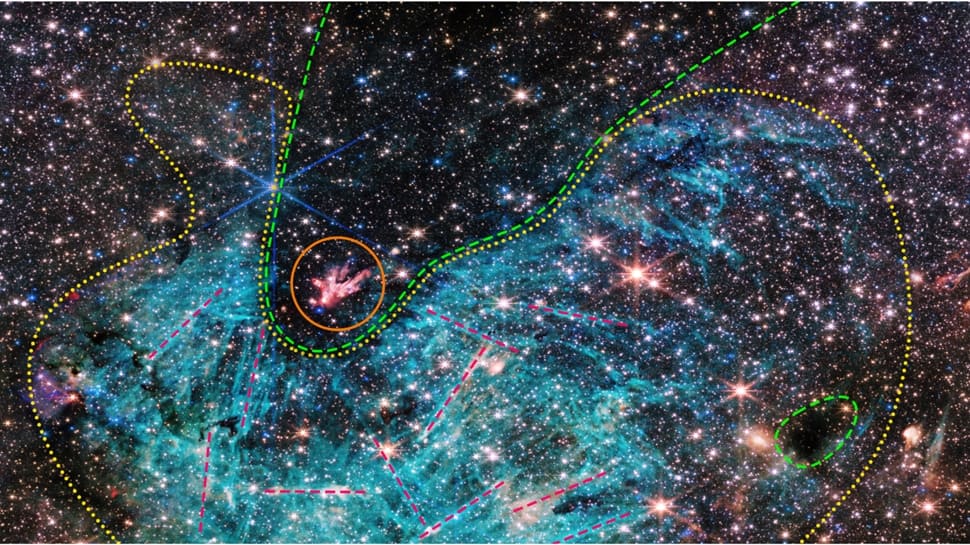5,00,000 Stars: NASA Releases 'Never-Before-Seen' Photo Of Star-Forming Region Sagittarius C
Nestled within this youthful cluster is a known massive protostar, surpassing 30 times the mass of our Sun.
Trending Photos
)
NASA's James Webb Space Telescope has delivered an awe-inspiring glimpse into the heart of our galaxy, revealing a mesmerizing sight of Sagittarius C (Sgr C), a star-forming region residing roughly 300 light-years away from Sagittarius A, the Milky Way's central supermassive black hole. In this recently captured image, among the abundant 5,00,000 stars, a collection of protostars steals the spotlight. These protostars, in their embryonic phase and gathering mass, emit blazing outflows that resemble a fiery display within an infrared-dark cloud.
“There’s never been any infrared data on this region with the level of resolution and sensitivity we get with Webb, so we are seeing lots of features here for the first time,” said the NASA in a release. The observation team’s principal investigator Samuel Crowe, an undergraduate student at the University of Virginia in Charlottesville, said, "Webb reveals an incredible amount of detail, allowing us to study star formation in this sort of environment in a way that wasn’t possible previously."
Pictured: An estimated 500,000 stars.
This is the heart of the Milky Way galaxy. @NASAWebb has revealed never-before-seen features in a star-forming region called Sagittarius C: https://t.co/ljZyx7qV2y pic.twitter.com/WgBH45qUyQ — NASA (@NASA) November 20, 2023
"The galactic center is the most extreme environment in our Milky Way galaxy, where current theories of star formation can be put to their most rigorous test," added professor Jonathan Tan, one of Crowe’s advisors at the University of Virginia.
Nestled within this youthful cluster is a known massive protostar, surpassing 30 times the mass of our Sun. Curiously, the density of the cloud shrouding these protostars obstructs the light from stars positioned behind it, creating the illusion of a less populated area when, in reality, it's one of the galaxy's most densely packed zones. The image showcases smaller infrared-dark clouds, resembling star-filled voids, where forthcoming stars are taking shape.

The NIRCam (Near-Infrared Camera) instrument of Webb's telescope has captured extensive ionized hydrogen emissions encircling the underside of the dark cloud, depicted in cyan hues. Usually attributed to energetic photons emitted by young massive stars, the extensive reach of this hydrogen region, a revelation brought to light by Webb, poses an intriguing puzzle requiring deeper exploration. Another enigmatic feature under scrutiny is the erratic needle-like structures within the ionized hydrogen, scattered chaotically in various directions, a phenomenon demanding further investigation by experts.
“The galactic center is a crowded, tumultuous place. There are turbulent, magnetized gas clouds that are forming stars, which then impact the surrounding gas with their outflowing winds, jets, and radiation,” said Rubén Fedriani, a co-investigator of the project at the Instituto Astrofísica de Andalucía in Spain.
As Webb's revelations continue to unfold, these stunning findings from the heart of our galaxy open doors to deeper cosmic secrets, beckoning scientists to unravel the mysteries shrouded within the celestial expanse. Around 25,000 light-years from Earth, the galactic center is close enough to study individual stars with the Webb telescope, allowing astronomers to gather unprecedented information on how stars form, and how this process may depend on the cosmic environment, especially compared to other regions of the galaxy.
Stay informed on all the latest news, real-time breaking news updates, and follow all the important headlines in india news and world News on Zee News.
Live Tv







)
)
)
)
)
)
)
)
)
)
